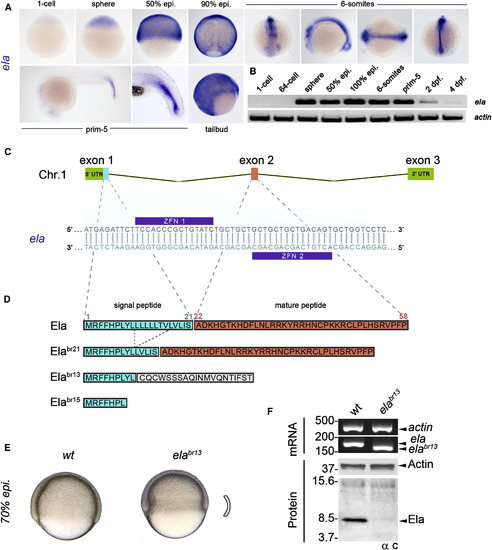Fig. 2
- ID
- ZDB-FIG-140116-2
- Publication
- Chng et al., 2013 - ELABELA: A Hormone Essential for Heart Development Signals via the Apelin Receptor
- Other Figures
- All Figure Page
- Back to All Figure Page
|
Generation of an Allelic Series of Mutant ela Zebrafish (A) By WISH in zebrafish embryos, ela is found to be zygotically expressed and ubiquitous in the blastoderm. During gastrulation, its expression becomes axial and is strongest in the neural tube. (B) RT-PCR analysis shows that, relative to actin, expression of ela is exclusively zygotic, peaking at 100% epiboly and becoming absent by 4 dpf. (C) In zebrafish, ela consists of three exons located on chromosome 1. A custom pair of ZFNs targeting exon 1 of ela was used to create an allelic series of mutations within the signal peptide of Ela. (D) Three distinct loss-of-function alleles were generated. The elabr21allele results in a unique 7 aa in-frame deletion in Ela’s signal peptide. Alleles elabr13 and elabr15 caused premature stop codons and disrupted the reading frame, resulting in no Ela mature peptide. (E) Relative to WT embryos, homozygous null elabr13 embryos show defective epiboly movements and a constricted germ ring at the involuting margin at 70% epiboly. (F) RT-PCR reveals that at 100% epiboly, endogenous ela and elabr13 mRNAs are of a distinct size. Western blotting using the α C antibody shows that endogenous Ela is recognized in WT embryos and is absent in null elabr13 siblings. |
| Gene: | |
|---|---|
| Fish: | |
| Anatomical Terms: | |
| Stage Range: | 1-cell to Long-pec |
| Fish: | |
|---|---|
| Observed In: | |
| Stage: | Shield |
Reprinted from Developmental Cell, 27(6), Chng, S.C., Ho, L., Tian, J., and Reversade, B., ELABELA: A Hormone Essential for Heart Development Signals via the Apelin Receptor, 672-680, Copyright (2013) with permission from Elsevier. Full text @ Dev. Cell

